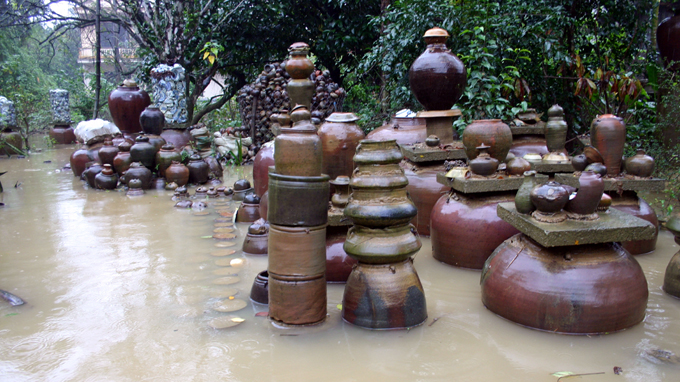A prized, awe-inspiring private collection of potteries dating back to the pre-Sa Huynh and Sa Huynh cultures (from the second millennium BC to the early AD) may add some thousands of years to the history of central Hue city, Vietnam’s former imperial capital.
Among researcher Ho Tan Phan’s several thousands of artifacts excavated from the Huong river bed, roughly 1,000 ones belong to the Sa Huynh culture and date back to some 2,500 years ago.
This prized collection, considered unique and unparalleled by Phan and several archeologists and historians, is much of the digging work by local fishermen and boatmen in the area’s rivers, especially the Huong river, which spans over 30 years and has never ceased till now.
The cherished collection
Phan began his extensive cultural and historical research before 1975 by voraciously reading books, especially old literature in Han (ancient Chinese) and Nom (Chinese-transcribed Vietnamese).
By sheer chance, his wife was gifted some pottery antiques in payment for helping a boatman’s wife deliver her child. The boatman then told the intrigued Phan that he had stumbled across the items in the Huong river bed.
As the poverty-stricken boatmen went diving for scraps, they came across pottery items and fetched the intact ones and put them casually about their dinghies. They also sold some at dirt-cheap prices.
During these 30 years, Phan purchased the potteries from the boatmen’s boatloads or from sellers on Tran Hung Dao street, Hue’s well-known antique trading rendezvous. His ‘pottery garden’ now contains several thousands of items.
The researcher’s most wondrous purchases were the pottery artifacts from the prehistoric and post-prehistoric times, including household items, containers, things to be buried along with the deceased, such as big vases and jars, as well as a host of objects with unknown purposes.
All are dexterously decorated with unique, exquisite patterns, including printed, sculpted, or chain-like ones.
Likely to extend Hue’s age
Prior to 1975, researchers had tremendous difficulty delving into Hue’s ancient history, as this period was hardly mentioned in the historical literature and few artifacts belonging to this period had been excavated.
Though the Nguyen dynasty (1802- 1945), Vietnam’s last monarchy reign, is profusely mentioned and Hue’s history is usually believed to span seven centuries, the first few centuries are touched on perfunctorily. The Champa period, spanning from the 1st to the 12th centuries, in this region also has yet to be looked into exhaustively.
In the early 20th century, as a tomb zone built by the prehistoric and post-prehistoric people was unearthed in central Quang Ngai province’s Sa Huynh area, experts believed that the Sa Huynh culture spanned from the province southward.
Not until after 1975 was the culture extended to central Quang Nam- Da Nang following several excavations.
Now a good number of artifacts digged up from the Huong river bed along with those unearthed in Hue’s Con Rang and Con Dai back in the 2000s cemented the historical fact that Thua Thien-Hue is also one of the Sa Huynh culture’s major sites, which means Hue’s age is likely to be extended by some thousands years.
Archeology Ph.D holder Nguyen Viet, director of the Southeast Asian Prehistory Center, revealed that some 3,000-4,000- year-old glazed terracotta and pottery artifacts, which are typically found at the country’s Bronze Age and early Iron Age sites, in Phan’s assemblage may point to the fact that Hue is likely to date back to even further than the Sa Huynh times, which is around 2,500 years ago.
“Phan’s collection vividly reflects the formation and interaction between different groups of people from the Sa Huynh, Champa and Dai Viet cultures manifest in the Huong river basin, which opens new windows for historians and cultural researchers,” remarked Prof. Lam Thi My Dung, director of the Anthropology Museum.
Dung added that the Champa pottery artifacts in Phan’s collection are so bountiful and diverse that experts can use them as materials for graduate and postgraduate archeological thesis.
“This would also help Phan categorize and systemize his huge heritage and introduce it as well as his tremendous preservation efforts to the public,” Dung elaborated.
Lecturer Nguyen Anh Thu commented that as one of the country’s largest private ‘museums’, Phan’s collection boasts a vast number of invaluable artifacts, including those which have yet to be unearthed in excavations, and vividly reflect almost all historical periods.



















































